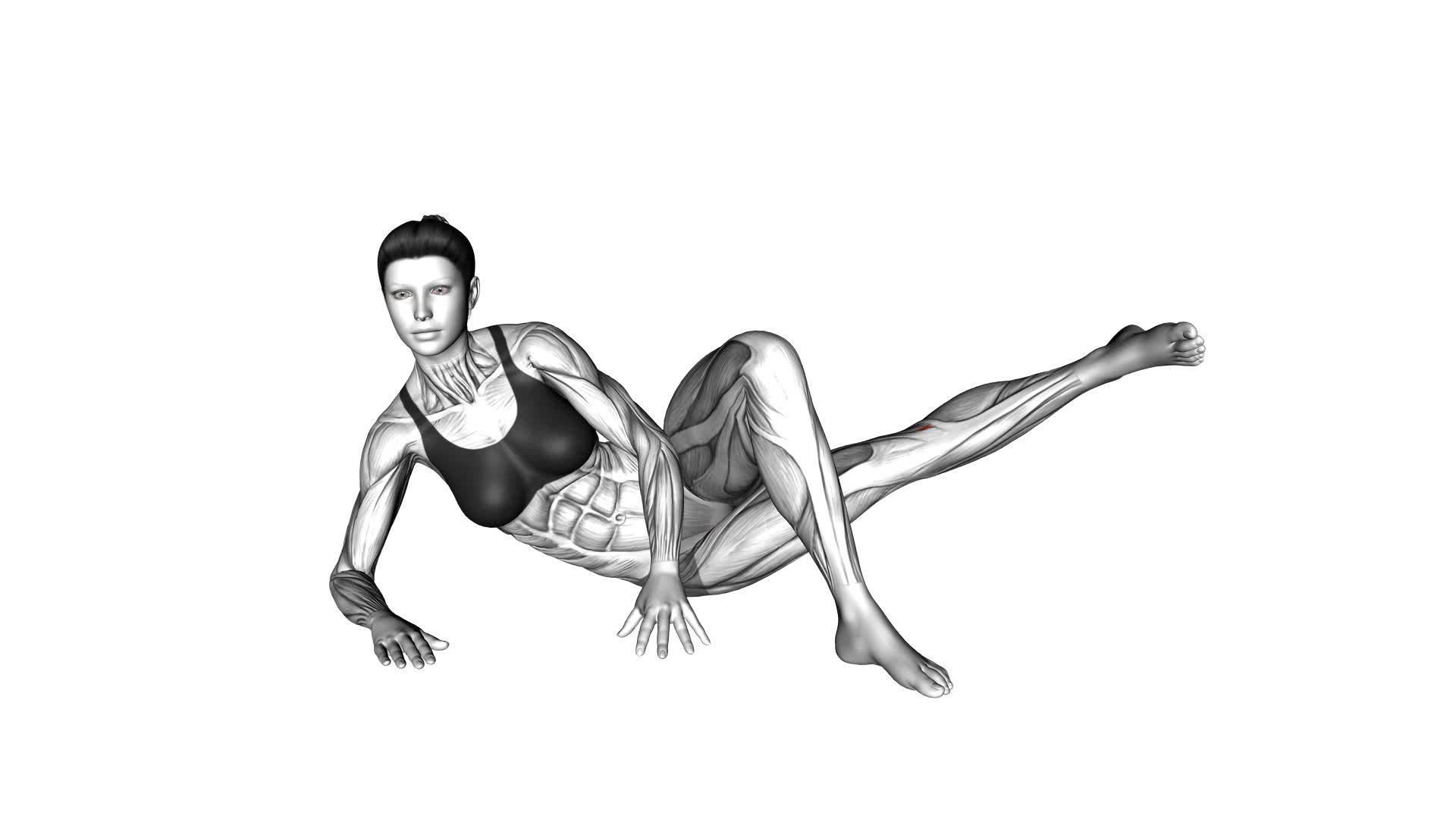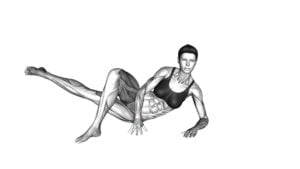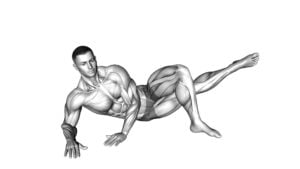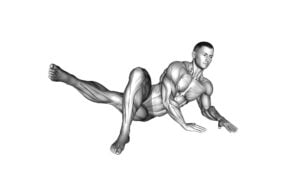Side Lying Hip Adduction (female) – Video Exercise Guide & Tips

Get ready to tone and strengthen your hips with side lying hip adduction. This exercise targets the inner thigh muscles, helping you achieve a lean and sculpted lower body.
Watch This Exercise Video
In this video exercise guide, you'll find step-by-step instructions and helpful tips to ensure proper form and technique. Whether you're a beginner or looking for advanced variations, we've got you covered.
Maximize your results and prevent injuries by following our expert advice.
Let's get started!
Key Takeaways
- Increased muscle activation of adductor muscles
- Improved overall lower body strength and stability
- Enhanced hip stability during various movements
- Reduction in the risk of injuries
Benefits of Side Lying Hip Adduction
You can experience several benefits from incorporating side lying hip adduction exercises into your workout routine. One of the main benefits is increased muscle activation. Side lying hip adduction specifically targets the adductor muscles of the hip, which are responsible for bringing the leg inward towards the midline of the body. By performing this exercise, you can effectively activate and strengthen these muscles, leading to improved overall lower body strength and stability.
Another benefit of side lying hip adduction exercises is the improvement of hip stability. The adductor muscles play a crucial role in maintaining proper hip alignment and stability during various movements, such as walking, running, and jumping. Weak or imbalanced adductor muscles can lead to poor hip stability and potentially increase the risk of injuries.
Incorporating side lying hip adduction exercises into your routine can help address any weaknesses or imbalances in the adductor muscles, leading to better hip stability and reducing the risk of injuries. Additionally, improved hip stability can enhance your overall performance in other exercises and activities, allowing you to move more efficiently and effectively.
Proper Form and Technique
To ensure proper form and technique during side lying hip adduction exercises, it's important to maintain a stable position and engage the correct muscles. One common mistake is allowing the hips to rotate forward or backward during the movement. To avoid this, start by lying on your side with your bottom leg straight and your top leg bent at a 90-degree angle. Keep your top foot in contact with the ground throughout the exercise. Engage your core muscles to stabilize your torso and prevent any unnecessary movement.
Another common mistake is using too much momentum or relying on gravity to perform the exercise. It's important to control the movement and focus on using the targeted muscles. To do this, slowly raise your top leg towards the ceiling, keeping your knee straight. Pause for a moment at the top of the movement, then slowly lower your leg back down to the starting position.
No equipment is needed for side lying hip adduction exercises. However, you can use a resistance band around your thighs to increase the intensity if desired. This will provide additional resistance and challenge your muscles even more.
Modifications for Beginners
If you're new to side lying hip adduction exercises, a helpful modification is to start with lighter resistance or fewer repetitions. This allows your body to gradually adapt to the exercise and reduces the risk of injury. Starting with lighter resistance can be done by using a lighter resistance band or by using no resistance at all. As you become more comfortable and confident with the exercise, you can gradually increase the resistance or add more repetitions to challenge yourself further.
Progression options for beginners include using a thicker resistance band, increasing the number of repetitions, or incorporating other variations of the exercise, such as side-lying clamshells or side plank hip adductions. These options can help you continue to improve your strength and stability.
To ensure proper form and technique, it's important to be mindful of some common mistakes. One common mistake is allowing your hips or upper body to rotate during the movement. To avoid this, engage your core and maintain a stable position throughout the exercise. Another mistake is using momentum to perform the movement instead of relying on your hip muscles. Focus on using your hip muscles to initiate and control the movement.
Advanced Variations for Increased Challenge
To further intensify your side lying hip adduction exercises, incorporate advanced variations that challenge your muscles and promote greater strength and stability.
One advanced variation you can try is using a resistance band. Simply wrap the band around your thighs, just above your knees, and perform the side lying hip adduction exercise as usual. The resistance provided by the band will increase the challenge on your adductor muscles, making them work even harder.
Another advanced modification is to perform the exercise on an unstable surface, such as a balance pad or Swiss ball. This forces your muscles to work harder to stabilize your body while performing the movement. It also engages your core muscles to a greater extent, improving overall stability and strength.
You can also incorporate a weighted ankle cuff or ankle weights to add extra resistance to the exercise. This increases the load on your muscles, making them work harder and promoting greater strength gains.
Remember to always start with a weight or resistance level that's challenging but manageable, and gradually increase the intensity as you become stronger. These advanced variations will help you continue to progress and achieve even greater results in your side lying hip adduction exercises.
Tips for Maximizing Results and Preventing Injury
To maximize your results and prevent injury, focus on proper form and technique while performing side lying hip adduction exercises. Here are some tips to help you get the most out of your workout while keeping yourself safe:
- Warm up: Prior to starting any exercise, it's important to warm up your body. Engage in a light cardiovascular activity like jogging or jumping jacks for 5-10 minutes. This will increase blood flow to your muscles and prepare them for the workout ahead.
- Engage your core: Throughout the exercise, make sure to engage your core muscles. This won't only help stabilize your body but also improve the effectiveness of the hip adduction movement.
- Control the movement: Avoid using momentum or swinging your leg during the exercise. Instead, focus on controlled and deliberate movements. This will target the muscles more effectively and reduce the risk of injury.
- Gradually increase intensity: Start with a weight or resistance level that challenges you but allows for proper form. As you get stronger, gradually increase the intensity by adding more resistance or repetitions. This progressive overload will help maximize your results over time.
Frequently Asked Questions
How Many Calories Can You Burn by Doing Side Lying Hip Adduction?
You can burn a significant amount of calories by doing side lying hip adduction. This exercise targets your hip muscles and helps to strengthen and tone them.
The effectiveness of side lying hip adduction in burning calories will depend on factors such as your body weight, intensity of the exercise, and duration of the workout. Incorporating this exercise into your routine can contribute to your overall calorie burning efforts and help you achieve your fitness goals.
Can Side Lying Hip Adduction Help Reduce Cellulite?
Side lying hip adduction exercises are great for beginners looking to tone their inner thighs and improve overall hip stability. They can also benefit athletes by strengthening the hip abductors and adductors, which can improve performance and reduce the risk of injury.
While side lying hip adduction exercises can help strengthen and tone the muscles, there's no scientific evidence to suggest that they can specifically reduce cellulite.
However, incorporating these exercises into a well-rounded fitness routine can contribute to overall body toning and improved muscle definition.
Is Side Lying Hip Adduction Suitable for Pregnant Women?
Side lying hip adduction, when modified for pregnancy, can be a beneficial exercise for pregnant women. It helps strengthen the hip muscles, improves stability, and can alleviate any discomfort caused by pregnancy-related changes in the body.
However, it's important to consult with your healthcare provider before incorporating this exercise into your routine. They can provide specific modifications and guidelines to ensure your safety and the safety of your baby during the exercise.
Can Side Lying Hip Adduction Help Improve Posture?
Side lying hip adduction is an effective exercise for improving posture. By targeting the muscles in your hips and lower back, this exercise helps strengthen and stabilize your core, which is vital for maintaining good posture.
Additionally, side lying hip adduction can also enhance flexibility in your hip muscles, which can further support proper alignment and prevent lower back pain.
Incorporating this exercise into your routine can be beneficial for improving your overall posture and reducing discomfort.
How Often Should I Perform Side Lying Hip Adduction Exercises to See Results?
To see results from side lying hip adduction exercises, you should perform them frequently. The frequency of side lying hip adduction depends on your fitness level and goals. As a general guideline, aim to do these exercises 2-3 times per week.
It's important to give your muscles time to rest and recover between sessions. The best time to perform side lying hip adduction is when you have a few minutes to spare, such as during a workout or as a standalone exercise.
Conclusion
Incorporating side lying hip adduction into your workout routine can provide numerous benefits, including improved hip strength and stability. By using proper form and technique, you can effectively target the muscles in your hip area.
Beginners can modify the exercise by using a resistance band or starting with lower intensity. For those looking for a greater challenge, advanced variations can be implemented.
Remember to follow these tips to maximize your results and prevent any potential injuries.

Author
Years ago, the spark of my life’s passion ignited in my mind the moment I stepped into the local gym for the first time. The inaugural bead of perspiration, the initial endeavor, the very first surge of endorphins, and a sense of pride that washed over me post-workout marked the beginning of my deep-seated interest in strength sports, fitness, and sports nutrition. This very curiosity blossomed rapidly into a profound fascination, propelling me to earn a Master’s degree in Physical Education from the Academy of Physical Education in Krakow, followed by a Sports Manager diploma from the Jagiellonian University. My journey of growth led me to gain more specialized qualifications, such as being a certified personal trainer with a focus on sports dietetics, a lifeguard, and an instructor for wellness and corrective gymnastics. Theoretical knowledge paired seamlessly with practical experience, reinforcing my belief that the transformation of individuals under my guidance was also a reflection of my personal growth. This belief holds true even today. Each day, I strive to push the boundaries and explore new realms. These realms gently elevate me to greater heights. The unique combination of passion for my field and the continuous quest for growth fuels my drive to break new ground.







